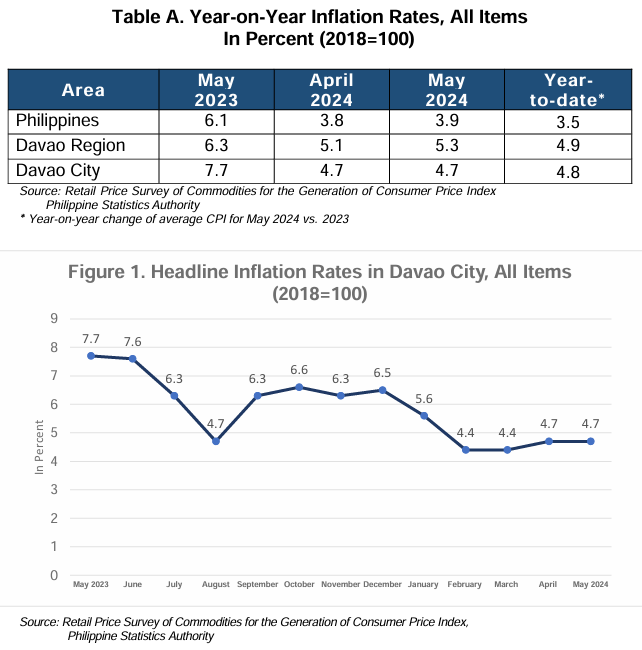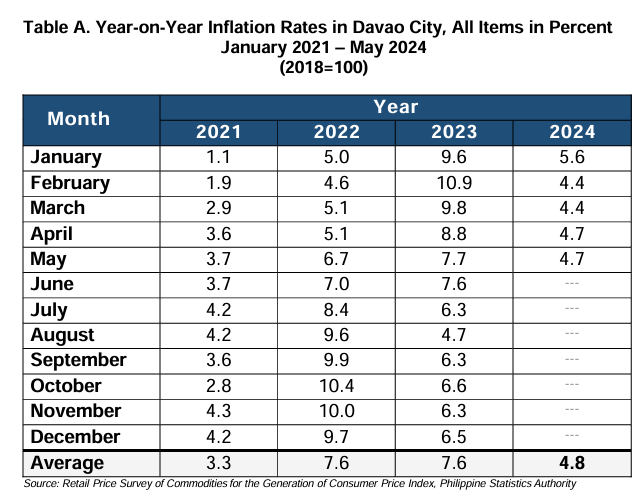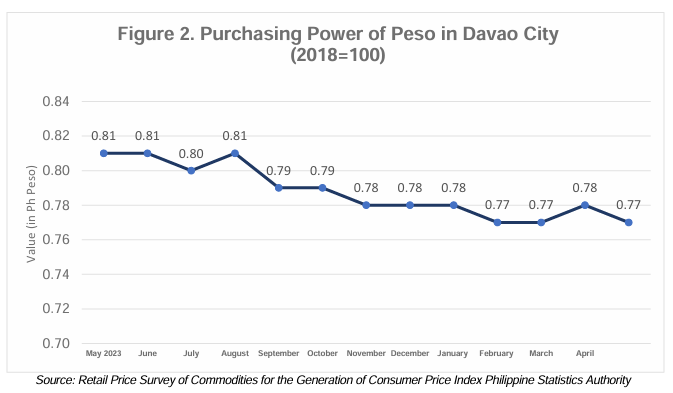
CITY OF DAVAO
1. Headline Inflation
In May 2024, the headline inflation rate in the City of Davao remained at 4.7 percent, same rate level in April 2024. Notably, the current inflation rate was 3.0 percentage points lower than the figure reported in May 2023. Meanwhile, the city's average inflation rate stands at 4.8 percent (Table A and Figure 1).
1.1 Increasing Commodities Despite Steady Headline Inflation
Despite no changes in the level of headline inflation, significant commodity groups have seen price decreases. These include (a) Food and Non-Alcoholic Beverages, which fell to 7.9 percent from 9.0 percent in the previous month; (b)Personal Care, and Miscellaneous Goods and Services, which decreased to 5.3 percent from 5.5 percent in the previous month; and (c) Clothing and Footwear, which declined to 4.7 percent from 5.1 percent in the previous month.
Compared to their annual rates in the previous month, lower year-on-year inflation rates were also observed in the following commodity groups:
a) Furnishings, Household Equipment and Routine Household
Maintenance at 3.3 percent;
b) Alcoholic Beverages and Tobacco at 3.7 percent; and
c) Recreation, Sport and Culture at 2.7 percent.
In contrast, several commodity groups experienced higher inflation rates in May 2024. Specifically, (a) Transport at 5.0 percent, from 4.3 percent; (b) Health at 4.8 percent, from 4.6 percent; and (c) Housing, Water, Electricity, Gas and Other Fuels at negative 1.4 percent, from negative 3.2 percent in the previous month.
The inflation rates for the rest of the commodities remained unchanged.

2. Food Inflation
Meanwhile, food inflation decreased to 8.0 percent in May 2024 from 9.2 percent in the previous month. The decrease of the food inflation was mainly due to a) Cereals and Cereal Products at 2.2 percent, from 23.7 percent in the previous month. This was followed by b) Fruits and nuts at 16.8 percent, from 18.6 percent in the previous month; and c) Ready-made food and other food products N.E.C. at 7.2 percent, from 7.5 in the previous month.
Lower year-on-year inflation rates were also observed in the following category:
a) Fish and other seafood at 0.4;
b) Milk, other dairy products and eggs at 0.0 percent; and
c) Meat and other parts of slaughtered land animals at negative 1.0 percent.
In contrast, the remaining food commodities experienced increasing rates
of inflation.
3. Purchasing Power of Peso
The Purchasing Power of Peso (PPP) in Davao City for May 2024 decreased at 0.77 percent, compared from 0.78 in the previous month, as illustrated in Figure 2. Furthermore, to purchase the same set of goods and services that cost Php 100 in 2018, one would require Php 129.50 in May 2024.

Technical Notes:
Consumer Price Index (CPI) - The CPI is an indicator of the change in the average retail prices of a fixed basket of goods and services commonly purchased by households relative to a base year.
Inflation Rate (IR) - The inflation rate is the annual rate of change, or the year-on-year change of the CPI expressed in percent. Inflation is interpreted in terms of declining purchasing power of money.
Headline Inflation - measures changes in the cost of living based on movements in the prices of a specified basket of major commodities. It refers to the annual rate of change or the yearon-year change in the Consumer Price Index (CPI).
Purchasing Power of the Peso (PPP) - The purchasing power of the peso shows how much the peso in the base period is worth in the current period. It is computed as the reciprocal of the CPI for the period under review multiplied by 100.
Approved for Release:
(SGD) ADELINE G. BATUCAN
(Supervising Statistical Specialist)
Officer-In-Charge
Davao del Sur Provincial Statistical Office
